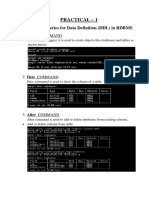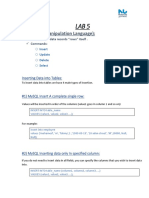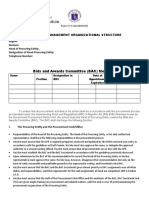0 ratings0% found this document useful (0 votes)
2 viewsReviewer SQL Lab2
The document discusses SQL aggregation and grouping, highlighting functions like SUM, AVG, and COUNT, and how to use GROUP BY and HAVING clauses for data summarization. It also covers SQL joins, including INNER JOIN, LEFT JOIN, RIGHT JOIN, FULL JOIN, CROSS JOIN, and SELF JOIN, explaining their use cases and how they relate tables. Additionally, it mentions UNION and UNION ALL for combining results from multiple SELECT queries.
Uploaded by
asraaCopyright
© © All Rights Reserved
Available Formats
Download as DOCX, PDF, TXT or read online on Scribd
0 ratings0% found this document useful (0 votes)
2 viewsReviewer SQL Lab2
The document discusses SQL aggregation and grouping, highlighting functions like SUM, AVG, and COUNT, and how to use GROUP BY and HAVING clauses for data summarization. It also covers SQL joins, including INNER JOIN, LEFT JOIN, RIGHT JOIN, FULL JOIN, CROSS JOIN, and SELF JOIN, explaining their use cases and how they relate tables. Additionally, it mentions UNION and UNION ALL for combining results from multiple SELECT queries.
Uploaded by
asraaCopyright
© © All Rights Reserved
Available Formats
Download as DOCX, PDF, TXT or read online on Scribd
You are on page 1/ 2
Reviewer: Selecting Data, Example Queries & Expected
Aggregation, and Grouping in Outputs
SQL 1. Total Salary per Department –
Uses `SUM(salary)` with `GROUP
Aggregation and Grouping in BY department`.
SQL 2. Average Salary per Job Title –
- Aggregation allows summarizing Uses `AVG(salary)` with `GROUP
data using functions like `SUM`, BY job_title`.
`COUNT`, `AVG`, etc. 3. Min & Max Salary per
- `GROUP BY` organizes data into Department – Uses `MIN(salary)`,
categories. `MAX(salary)`.
- `HAVING` filters grouped data 4. Grouping by Year of Hire – Uses
based on conditions. `YEAR(hire_date)` with `GROUP
Common Aggregate Functions BY`.
1. `SUM(column)` – Returns the
total sum of values. Reviewer: Selecting Data &
2. `COUNT(column)` – Returns Joining Tables in SQL
the number of rows (ignores Introduction to SQL Joins
`NULL`). - Joining tables in SQL allows
3. `AVG(column)` – Returns retrieving data from multiple
the average value. related tables using a common
4. `MIN(column)` – Returns field.
the smallest value. - Relational databases use foreign
5. `MAX(column)` – Returns keys to establish relationships
the largest value. between tables.
Using the GROUP BY Clause Common Types of Joins in SQL
- Groups rows that share the same 1. INNER JOIN (Default Join)
values. - Returns only the rows where
- Used with aggregate functions to there is a match between both
organize data meaningfully. tables.
- Example: Counting employees - Rows without matching records
per department. are excluded.
Filtering Groups with HAVING - Use Case: When you need data
- `HAVING` filters results after that exists in both tables (e.g.,
`GROUP BY`. employees belonging to a
- Used with aggregate functions department).
(unlike `WHERE`, which filters 2. LEFT JOIN (LEFT OUTER
before grouping). JOIN)
- Example: Finding departments - Returns all records from the
where total salary exceeds left table and matching records
170,000. from the right table.
Combining WHERE, GROUP - If no match is found, `NULL`
BY, and HAVING values are returned for the right
- `WHERE` filters before grouping. table.
- `GROUP BY` organizes data. - Use Case: To see all
- `HAVING` filters after employees, including those
grouping. without a department.
- Use Case: Merging datasets from
multiple sources (e.g., combining
retail and online customer lists).
3. RIGHT JOIN (RIGHT OUTER Examples & Expected Outputs
JOIN) 1. Employees per Department
- Returns all records from the using INNER JOIN.
right table and matching records 2. All Employees (even without a
from the left table. department) using LEFT JOIN.
- If no match exists, `NULL` 3. All Departments (even without
values appear for the left table. employees) using RIGHT JOIN.
- Use Case: To see all 4. Merging two customer lists
departments, including those using UNION and UNION ALL.
without employees.
4. FULL JOIN (FULL OUTER
JOIN)
- Combines results of LEFT JOIN
and RIGHT JOIN.
- Returns all records from both
tables, with `NULL` values where
no match is found.
- Use Case: When a complete
dataset, including unmatched
records from both tables, is
needed.
5. CROSS JOIN
- Creates a Cartesian product
(every row from the first table
joins with every row from the
second table).
- Use Case: To generate all
possible combinations (e.g.,
pairing all employees with all
departments for testing).
6. SELF JOIN
- A table joins with itself, useful
for hierarchical relationships (e.g.,
employees and their managers).
- Use Case: Working with
hierarchical data like reporting
structures (e.g., employees
reporting to managers).
UNION and UNION ALL
- Used to combine results of
multiple `SELECT` queries into
one result set.
- UNION removes duplicates, while
UNION ALL retains all records.
You might also like
- IDAB Assignment 3: 1. Explain SQL SubqueriesNo ratings yetIDAB Assignment 3: 1. Explain SQL Subqueries6 pages
- SQL Notes Basic To Advanced (SQL Clauses)No ratings yetSQL Notes Basic To Advanced (SQL Clauses)10 pages
- (PARUCHURI SUPRAJA) December23(Data Base module2)assignmentsNo ratings yet(PARUCHURI SUPRAJA) December23(Data Base module2)assignments8 pages
- Electronic Spreadsheet (Advanced) NotesNo ratings yetElectronic Spreadsheet (Advanced) Notes25 pages
- Lab-12-Manual-[Reporting Aggregated data using GROUP BY]No ratings yetLab-12-Manual-[Reporting Aggregated data using GROUP BY]11 pages
- 4 Group by Clause, Having Clause, Multiple Row (Or Group or Aggregate) Functions100% (1)4 Group by Clause, Having Clause, Multiple Row (Or Group or Aggregate) Functions17 pages
- Week 11 (Oct 19-24) MC Group Functions and JoinNo ratings yetWeek 11 (Oct 19-24) MC Group Functions and Join47 pages
- Unit I: DBMS (Database Management System)No ratings yetUnit I: DBMS (Database Management System)26 pages
- ITE407 - Advanced Databases Group Fns LectureNotes 02212017No ratings yetITE407 - Advanced Databases Group Fns LectureNotes 022120174 pages
- The Function of Figures in Microsoft Office Excel and Google SpreadsheetsNo ratings yetThe Function of Figures in Microsoft Office Excel and Google Spreadsheets14 pages
- Week 7 -- Day 1-4 --Grouping Data With GROUP ByNo ratings yetWeek 7 -- Day 1-4 --Grouping Data With GROUP By2 pages
- Did You Look at The Execution Time of The Data Provider?No ratings yetDid You Look at The Execution Time of The Data Provider?4 pages
- MS Excel Bible, Save Your Time With MS Excel!: 8 Quality Excel Books in 1 PackageFrom EverandMS Excel Bible, Save Your Time With MS Excel!: 8 Quality Excel Books in 1 PackageNo ratings yet
- The Effect of Daily Allowance To The Academic Performance of The Grade 12 Students in Colegio de Maharlika of North Cotabato, Inc100% (1)The Effect of Daily Allowance To The Academic Performance of The Grade 12 Students in Colegio de Maharlika of North Cotabato, Inc8 pages
- Automatic Capsule Filling Machine NJP-1200CNo ratings yetAutomatic Capsule Filling Machine NJP-1200C42 pages
- Department of Education: Bids and Awards Committee (BAC) MembersNo ratings yetDepartment of Education: Bids and Awards Committee (BAC) Members3 pages
- Category-I: Northern Region (Critical & Non-Critical)No ratings yetCategory-I: Northern Region (Critical & Non-Critical)26 pages
- Newton Cotes Integration Method: Prepared By:-Pabari ShashikantNo ratings yetNewton Cotes Integration Method: Prepared By:-Pabari Shashikant23 pages
- A Study On Customer Relationship Management at Anantha PVC Pipes, AnantapurNo ratings yetA Study On Customer Relationship Management at Anantha PVC Pipes, Anantapur4 pages
- Photoelectric Vs Ionization Detectors - A Review of The LiteratureNo ratings yetPhotoelectric Vs Ionization Detectors - A Review of The Literature37 pages
- Skills Framwork For The Information Age v6 PDFNo ratings yetSkills Framwork For The Information Age v6 PDF2 pages
- Heart Images - Free Photos, PNG Stickers, Wallpapers & Backgrounds - RawpixelNo ratings yetHeart Images - Free Photos, PNG Stickers, Wallpapers & Backgrounds - Rawpixel1 page
- Release Notes For Cisco Catalyst 9800 Series Wireless Controller, Cisco IOS XE Bengaluru 17.6.xNo ratings yetRelease Notes For Cisco Catalyst 9800 Series Wireless Controller, Cisco IOS XE Bengaluru 17.6.x57 pages
- Immediate download Generative Deep Learning 1st Edition David Foster ebooks 2024100% (11)Immediate download Generative Deep Learning 1st Edition David Foster ebooks 202440 pages
- Solutions Gold Intermediate Progress Test Unit 5BNo ratings yetSolutions Gold Intermediate Progress Test Unit 5B6 pages
- Project Report 2004 Solar: A Solar System Simulator Author: Sam Morris Supervisor: Dr. Richard BanachNo ratings yetProject Report 2004 Solar: A Solar System Simulator Author: Sam Morris Supervisor: Dr. Richard Banach56 pages





























































































